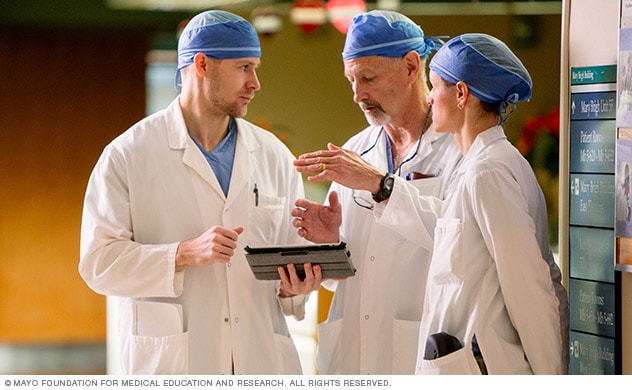Your Mayo Clinic care team

Orthopedic surgeons discuss an upcoming procedure at Mayo Clinic.
Mayo Clinic orthopedic specialists work together as a multidisciplinary team with oncologists, microvascular surgeons, plastic surgeons and other specialists to evaluate and treat each individual condition. This means that you're not getting just one opinion — you benefit from the knowledge and experience of each specialist on the multidisciplinary team.
Close collaboration enables your medical team to have your test results available quickly and then appropriately schedule your appointments across a team of specialists.
Seeking new knowledge and more-effective treatments for bone cancer, Mayo Clinic doctors continually study new diagnostic and treatment options and test them through clinical trials. Through this wide research network, you have direct access to the expertise of Mayo Clinic clinician-researchers.
Advanced diagnosis and treatment

A Mayo Clinic surgeon consults with a patient.
With state-of-the-art research and laboratory facilities, the specialists on the bone cancer team at Mayo Clinic use sophisticated imaging tests and comprehensive physical examinations to obtain a detailed, accurate diagnosis.
Mayo Clinic's team of bone cancer experts has ready access to the latest technology to improve care for people with bone cancer. Mayo Clinic specialists use advanced techniques, such as intensity-modulated radiation therapy (IMRT), stereotactic radiosurgery and radiofrequency ablation for cancer.
Mayo Clinic also offers an advanced proton beam therapy program. In proton therapy, a high dose of radiation can be delivered to a tumor while minimizing the dose to adjacent normal tissues.
Specialists in pediatric care
A special strength of Mayo Clinic's bone cancer program is treating childhood bone cancer. The pediatric oncologists, orthopedic doctors and other specialists at Mayo Clinic are adept at diagnosing and treating infants and children with bone cancer and lead national trials in this field.
Certain chemotherapy and radiation treatments increase the risk of impaired fertility. As part of the Mayo Clinic Children's Center, the Fertility Preservation Program staff evaluates children with cancer whose disease and treatment could affect future fertility. Fertility preservation services are also available for adults.
Innovative surgical procedures
Mayo Clinic orthopedic surgeons employ the most advanced surgical options for limb reconstruction. For bone cancers near the knee, a rotationplasty can remove the cancerous tissue and then rotate and reattach the lower portion of the leg so that the ankle can serve as a replacement knee joint.
Older patients may be candidates to have the entire bone replaced with a prosthetic device made of metal and hard plastic. In children, a special prosthesis can be used that can be expanded as the child grows. In select cases, 3-D printers are used to plan complex operations and reconstructions.